Strategic Analysis of Telstra: PESTLE, SWOT, Porter's Five Forces
VerifiedAdded on 2023/05/28
|10
|1839
|299
Report
AI Summary
This report provides a comprehensive analysis of Telstra Corporation's competitive strategy using various strategic tools. It begins with a PESTLE analysis, examining the political, economic, social, technological, legal, and environmental factors affecting Telstra. A SWOT analysis identifies Telstra's strengths, weaknesses, opportunities, and threats, highlighting its dominant market position and potential for expansion. The report then applies Porter's Five Forces to assess the competitive intensity of the telecommunications industry, focusing on threats of new entrants, bargaining power of suppliers and buyers, threats of substitute products, and rivalry among existing competitors. Finally, the Ansoff Matrix explores Telstra's growth strategies, including market penetration, product development, market development, and diversification. The report concludes that while Telstra effectively uses these strategic tools, it needs to expand its business outside Australia to achieve economies of scale and reduce market threats. Desklib offers this and other solved assignments to aid students in their studies.
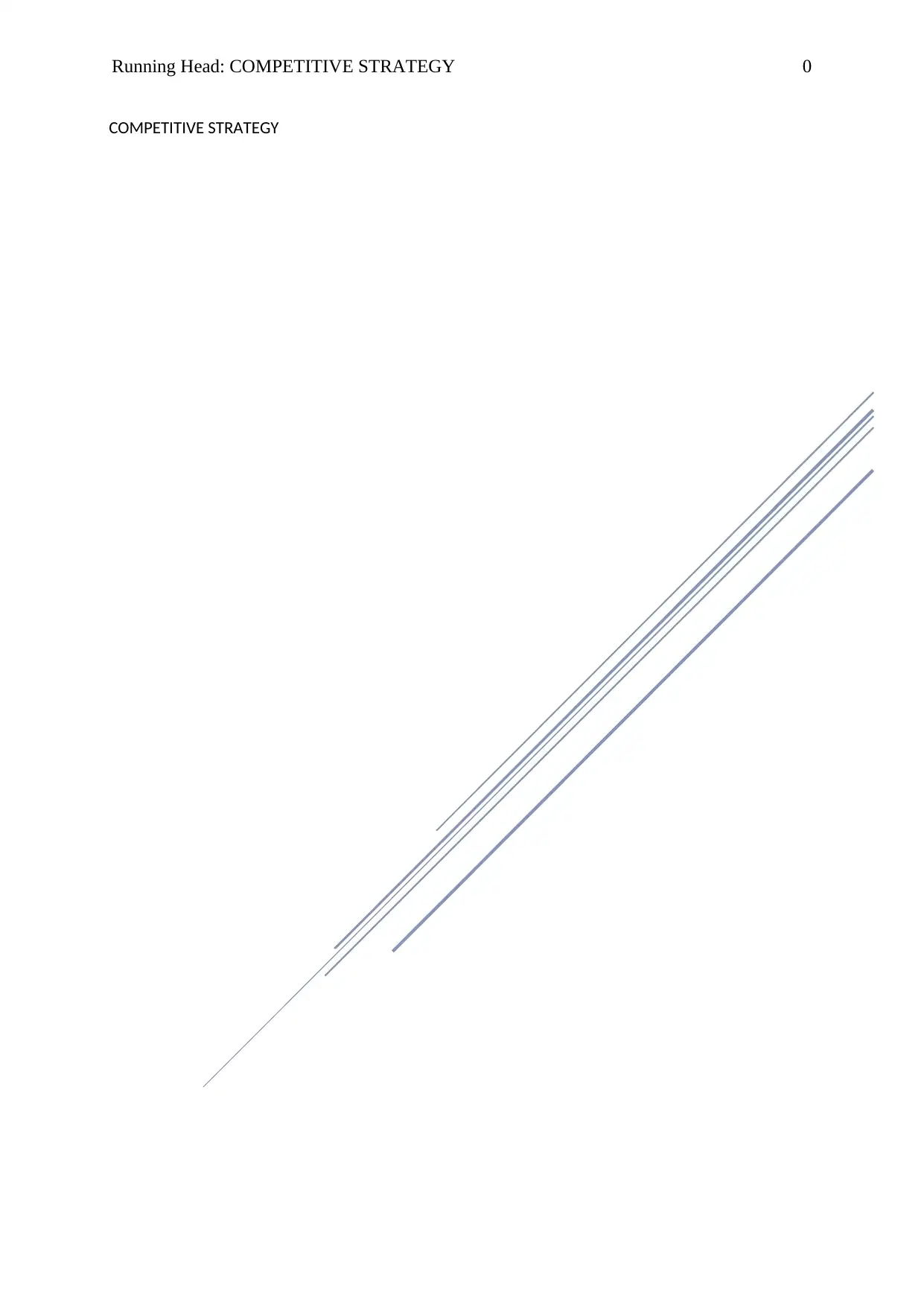
Running Head: COMPETITIVE STRATEGY 0
COMPETITIVE STRATEGY
COMPETITIVE STRATEGY
Paraphrase This Document
Need a fresh take? Get an instant paraphrase of this document with our AI Paraphraser
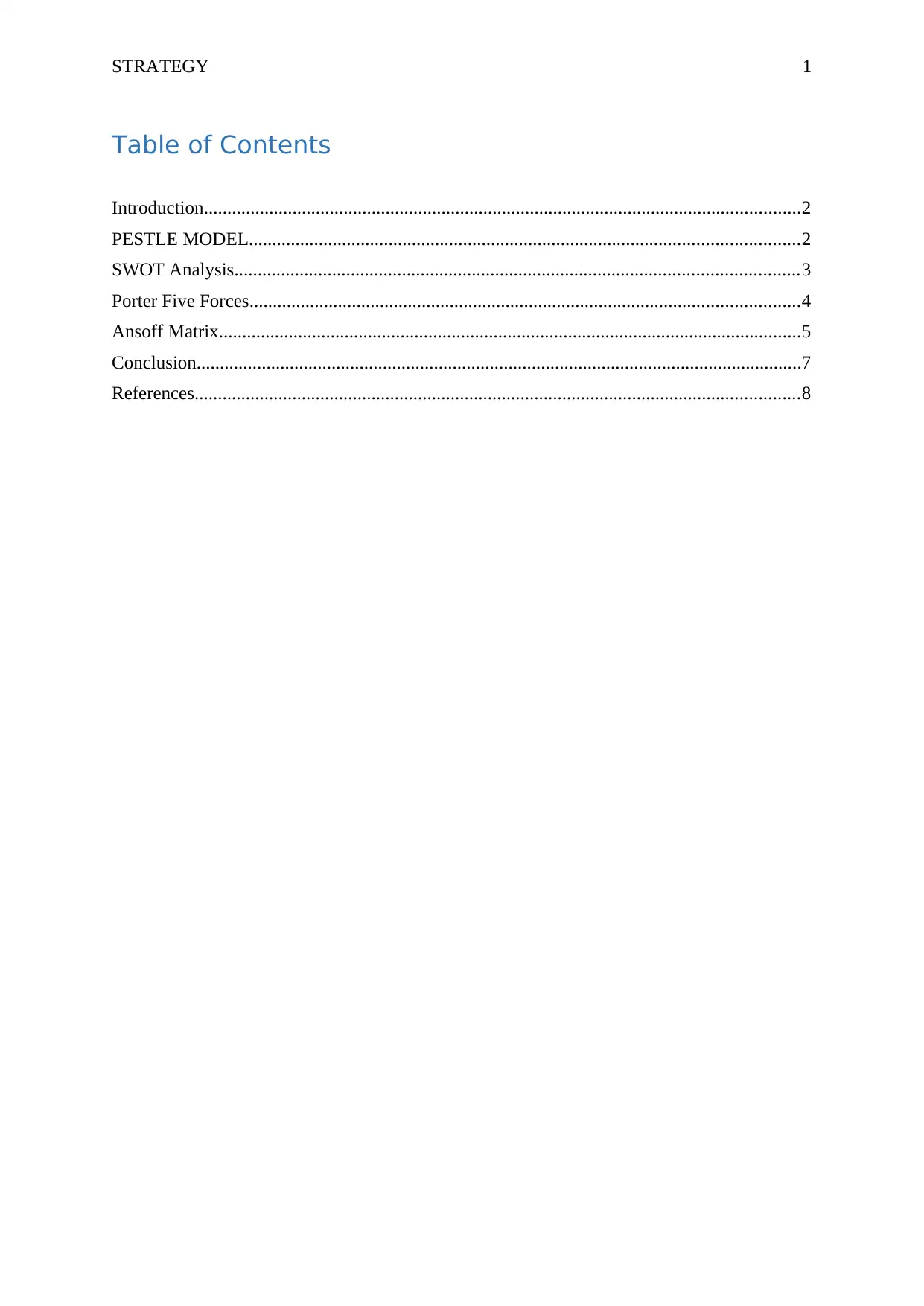
STRATEGY 1
Table of Contents
Introduction................................................................................................................................2
PESTLE MODEL......................................................................................................................2
SWOT Analysis.........................................................................................................................3
Porter Five Forces......................................................................................................................4
Ansoff Matrix.............................................................................................................................5
Conclusion..................................................................................................................................7
References..................................................................................................................................8
Table of Contents
Introduction................................................................................................................................2
PESTLE MODEL......................................................................................................................2
SWOT Analysis.........................................................................................................................3
Porter Five Forces......................................................................................................................4
Ansoff Matrix.............................................................................................................................5
Conclusion..................................................................................................................................7
References..................................................................................................................................8
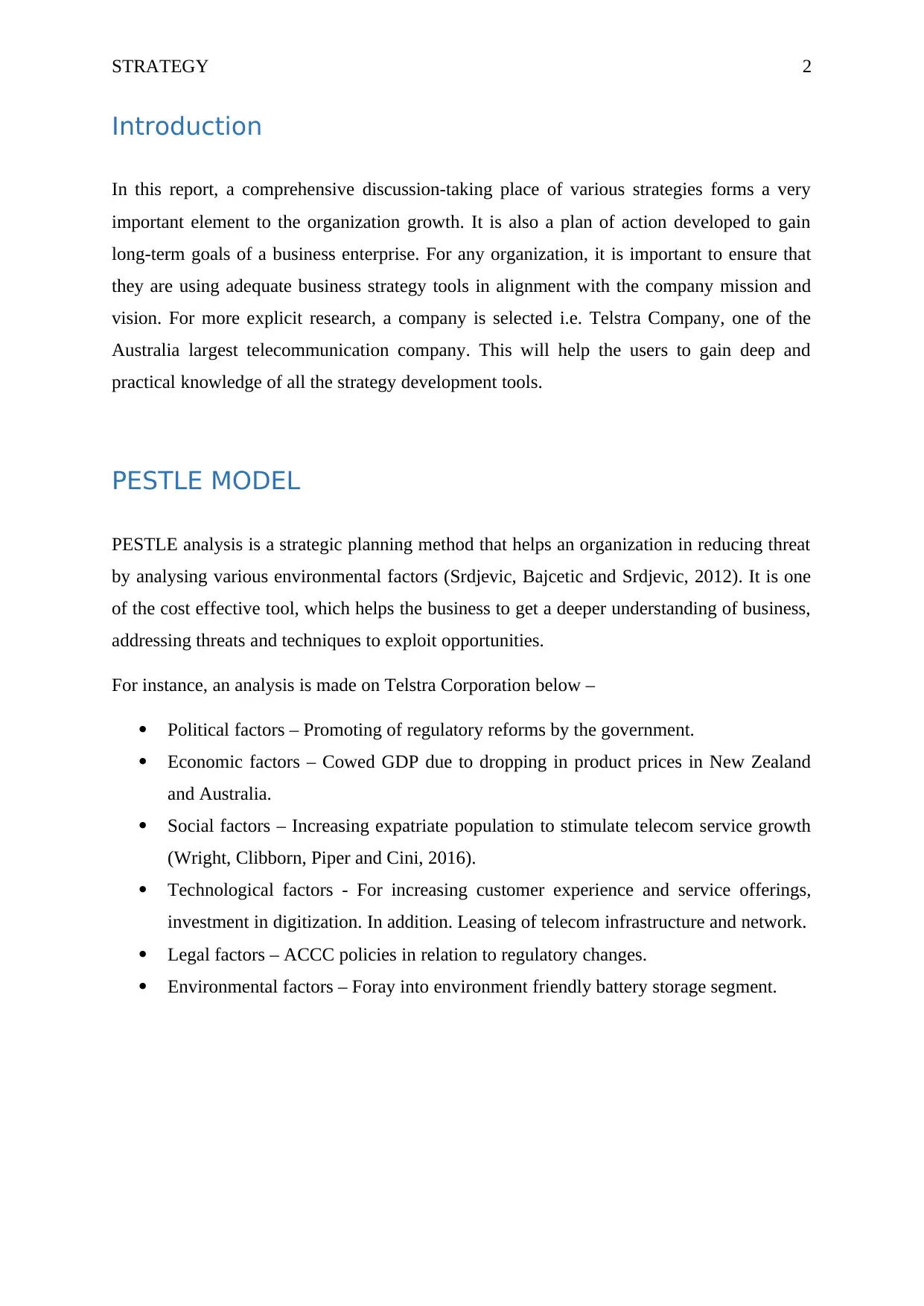
STRATEGY 2
Introduction
In this report, a comprehensive discussion-taking place of various strategies forms a very
important element to the organization growth. It is also a plan of action developed to gain
long-term goals of a business enterprise. For any organization, it is important to ensure that
they are using adequate business strategy tools in alignment with the company mission and
vision. For more explicit research, a company is selected i.e. Telstra Company, one of the
Australia largest telecommunication company. This will help the users to gain deep and
practical knowledge of all the strategy development tools.
PESTLE MODEL
PESTLE analysis is a strategic planning method that helps an organization in reducing threat
by analysing various environmental factors (Srdjevic, Bajcetic and Srdjevic, 2012). It is one
of the cost effective tool, which helps the business to get a deeper understanding of business,
addressing threats and techniques to exploit opportunities.
For instance, an analysis is made on Telstra Corporation below –
Political factors – Promoting of regulatory reforms by the government.
Economic factors – Cowed GDP due to dropping in product prices in New Zealand
and Australia.
Social factors – Increasing expatriate population to stimulate telecom service growth
(Wright, Clibborn, Piper and Cini, 2016).
Technological factors - For increasing customer experience and service offerings,
investment in digitization. In addition. Leasing of telecom infrastructure and network.
Legal factors – ACCC policies in relation to regulatory changes.
Environmental factors – Foray into environment friendly battery storage segment.
Introduction
In this report, a comprehensive discussion-taking place of various strategies forms a very
important element to the organization growth. It is also a plan of action developed to gain
long-term goals of a business enterprise. For any organization, it is important to ensure that
they are using adequate business strategy tools in alignment with the company mission and
vision. For more explicit research, a company is selected i.e. Telstra Company, one of the
Australia largest telecommunication company. This will help the users to gain deep and
practical knowledge of all the strategy development tools.
PESTLE MODEL
PESTLE analysis is a strategic planning method that helps an organization in reducing threat
by analysing various environmental factors (Srdjevic, Bajcetic and Srdjevic, 2012). It is one
of the cost effective tool, which helps the business to get a deeper understanding of business,
addressing threats and techniques to exploit opportunities.
For instance, an analysis is made on Telstra Corporation below –
Political factors – Promoting of regulatory reforms by the government.
Economic factors – Cowed GDP due to dropping in product prices in New Zealand
and Australia.
Social factors – Increasing expatriate population to stimulate telecom service growth
(Wright, Clibborn, Piper and Cini, 2016).
Technological factors - For increasing customer experience and service offerings,
investment in digitization. In addition. Leasing of telecom infrastructure and network.
Legal factors – ACCC policies in relation to regulatory changes.
Environmental factors – Foray into environment friendly battery storage segment.
⊘ This is a preview!⊘
Do you want full access?
Subscribe today to unlock all pages.

Trusted by 1+ million students worldwide
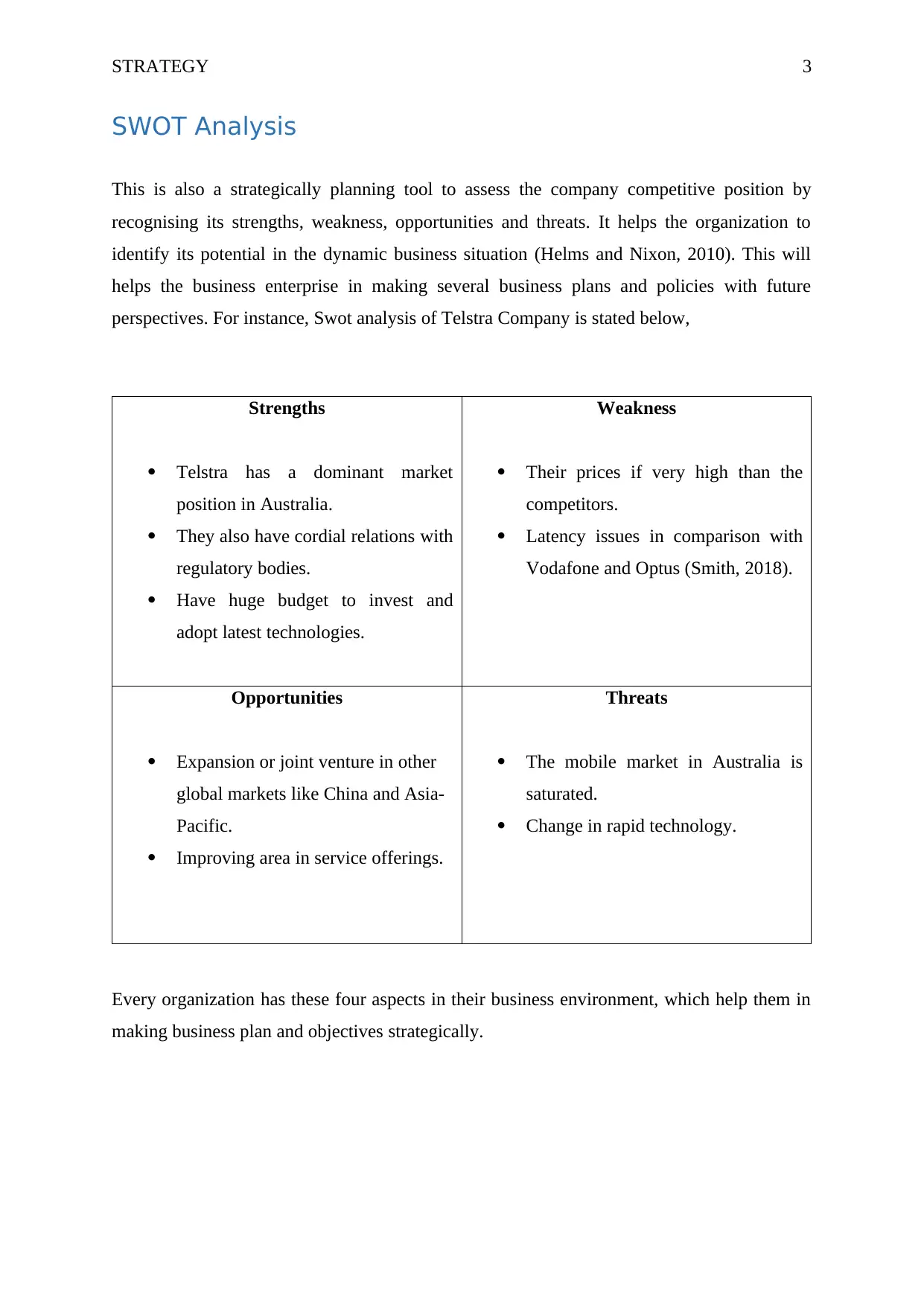
STRATEGY 3
SWOT Analysis
This is also a strategically planning tool to assess the company competitive position by
recognising its strengths, weakness, opportunities and threats. It helps the organization to
identify its potential in the dynamic business situation (Helms and Nixon, 2010). This will
helps the business enterprise in making several business plans and policies with future
perspectives. For instance, Swot analysis of Telstra Company is stated below,
Strengths
Telstra has a dominant market
position in Australia.
They also have cordial relations with
regulatory bodies.
Have huge budget to invest and
adopt latest technologies.
Weakness
Their prices if very high than the
competitors.
Latency issues in comparison with
Vodafone and Optus (Smith, 2018).
Opportunities
Expansion or joint venture in other
global markets like China and Asia-
Pacific.
Improving area in service offerings.
Threats
The mobile market in Australia is
saturated.
Change in rapid technology.
Every organization has these four aspects in their business environment, which help them in
making business plan and objectives strategically.
SWOT Analysis
This is also a strategically planning tool to assess the company competitive position by
recognising its strengths, weakness, opportunities and threats. It helps the organization to
identify its potential in the dynamic business situation (Helms and Nixon, 2010). This will
helps the business enterprise in making several business plans and policies with future
perspectives. For instance, Swot analysis of Telstra Company is stated below,
Strengths
Telstra has a dominant market
position in Australia.
They also have cordial relations with
regulatory bodies.
Have huge budget to invest and
adopt latest technologies.
Weakness
Their prices if very high than the
competitors.
Latency issues in comparison with
Vodafone and Optus (Smith, 2018).
Opportunities
Expansion or joint venture in other
global markets like China and Asia-
Pacific.
Improving area in service offerings.
Threats
The mobile market in Australia is
saturated.
Change in rapid technology.
Every organization has these four aspects in their business environment, which help them in
making business plan and objectives strategically.
Paraphrase This Document
Need a fresh take? Get an instant paraphrase of this document with our AI Paraphraser
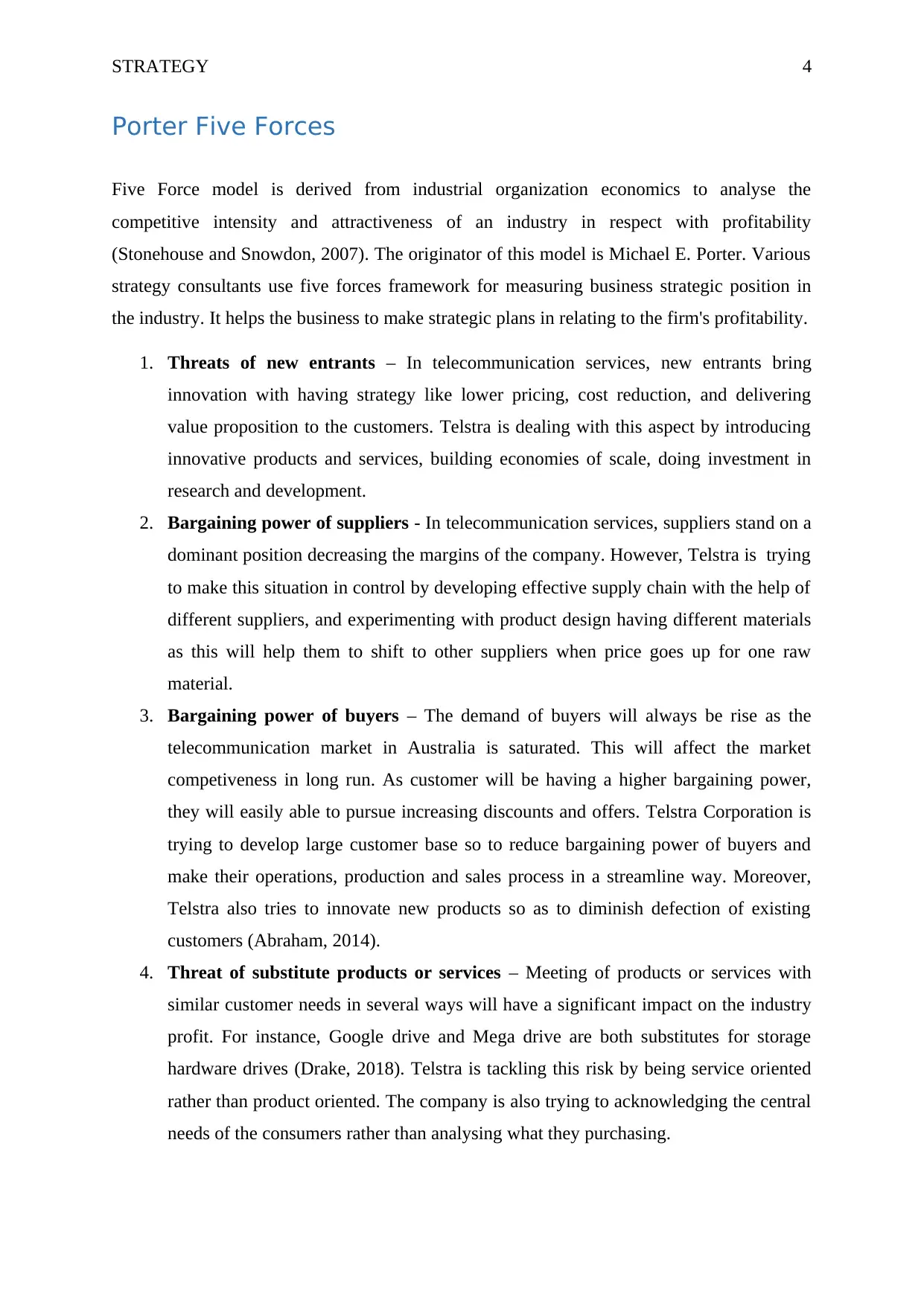
STRATEGY 4
Porter Five Forces
Five Force model is derived from industrial organization economics to analyse the
competitive intensity and attractiveness of an industry in respect with profitability
(Stonehouse and Snowdon, 2007). The originator of this model is Michael E. Porter. Various
strategy consultants use five forces framework for measuring business strategic position in
the industry. It helps the business to make strategic plans in relating to the firm's profitability.
1. Threats of new entrants – In telecommunication services, new entrants bring
innovation with having strategy like lower pricing, cost reduction, and delivering
value proposition to the customers. Telstra is dealing with this aspect by introducing
innovative products and services, building economies of scale, doing investment in
research and development.
2. Bargaining power of suppliers - In telecommunication services, suppliers stand on a
dominant position decreasing the margins of the company. However, Telstra is trying
to make this situation in control by developing effective supply chain with the help of
different suppliers, and experimenting with product design having different materials
as this will help them to shift to other suppliers when price goes up for one raw
material.
3. Bargaining power of buyers – The demand of buyers will always be rise as the
telecommunication market in Australia is saturated. This will affect the market
competiveness in long run. As customer will be having a higher bargaining power,
they will easily able to pursue increasing discounts and offers. Telstra Corporation is
trying to develop large customer base so to reduce bargaining power of buyers and
make their operations, production and sales process in a streamline way. Moreover,
Telstra also tries to innovate new products so as to diminish defection of existing
customers (Abraham, 2014).
4. Threat of substitute products or services – Meeting of products or services with
similar customer needs in several ways will have a significant impact on the industry
profit. For instance, Google drive and Mega drive are both substitutes for storage
hardware drives (Drake, 2018). Telstra is tackling this risk by being service oriented
rather than product oriented. The company is also trying to acknowledging the central
needs of the consumers rather than analysing what they purchasing.
Porter Five Forces
Five Force model is derived from industrial organization economics to analyse the
competitive intensity and attractiveness of an industry in respect with profitability
(Stonehouse and Snowdon, 2007). The originator of this model is Michael E. Porter. Various
strategy consultants use five forces framework for measuring business strategic position in
the industry. It helps the business to make strategic plans in relating to the firm's profitability.
1. Threats of new entrants – In telecommunication services, new entrants bring
innovation with having strategy like lower pricing, cost reduction, and delivering
value proposition to the customers. Telstra is dealing with this aspect by introducing
innovative products and services, building economies of scale, doing investment in
research and development.
2. Bargaining power of suppliers - In telecommunication services, suppliers stand on a
dominant position decreasing the margins of the company. However, Telstra is trying
to make this situation in control by developing effective supply chain with the help of
different suppliers, and experimenting with product design having different materials
as this will help them to shift to other suppliers when price goes up for one raw
material.
3. Bargaining power of buyers – The demand of buyers will always be rise as the
telecommunication market in Australia is saturated. This will affect the market
competiveness in long run. As customer will be having a higher bargaining power,
they will easily able to pursue increasing discounts and offers. Telstra Corporation is
trying to develop large customer base so to reduce bargaining power of buyers and
make their operations, production and sales process in a streamline way. Moreover,
Telstra also tries to innovate new products so as to diminish defection of existing
customers (Abraham, 2014).
4. Threat of substitute products or services – Meeting of products or services with
similar customer needs in several ways will have a significant impact on the industry
profit. For instance, Google drive and Mega drive are both substitutes for storage
hardware drives (Drake, 2018). Telstra is tackling this risk by being service oriented
rather than product oriented. The company is also trying to acknowledging the central
needs of the consumers rather than analysing what they purchasing.
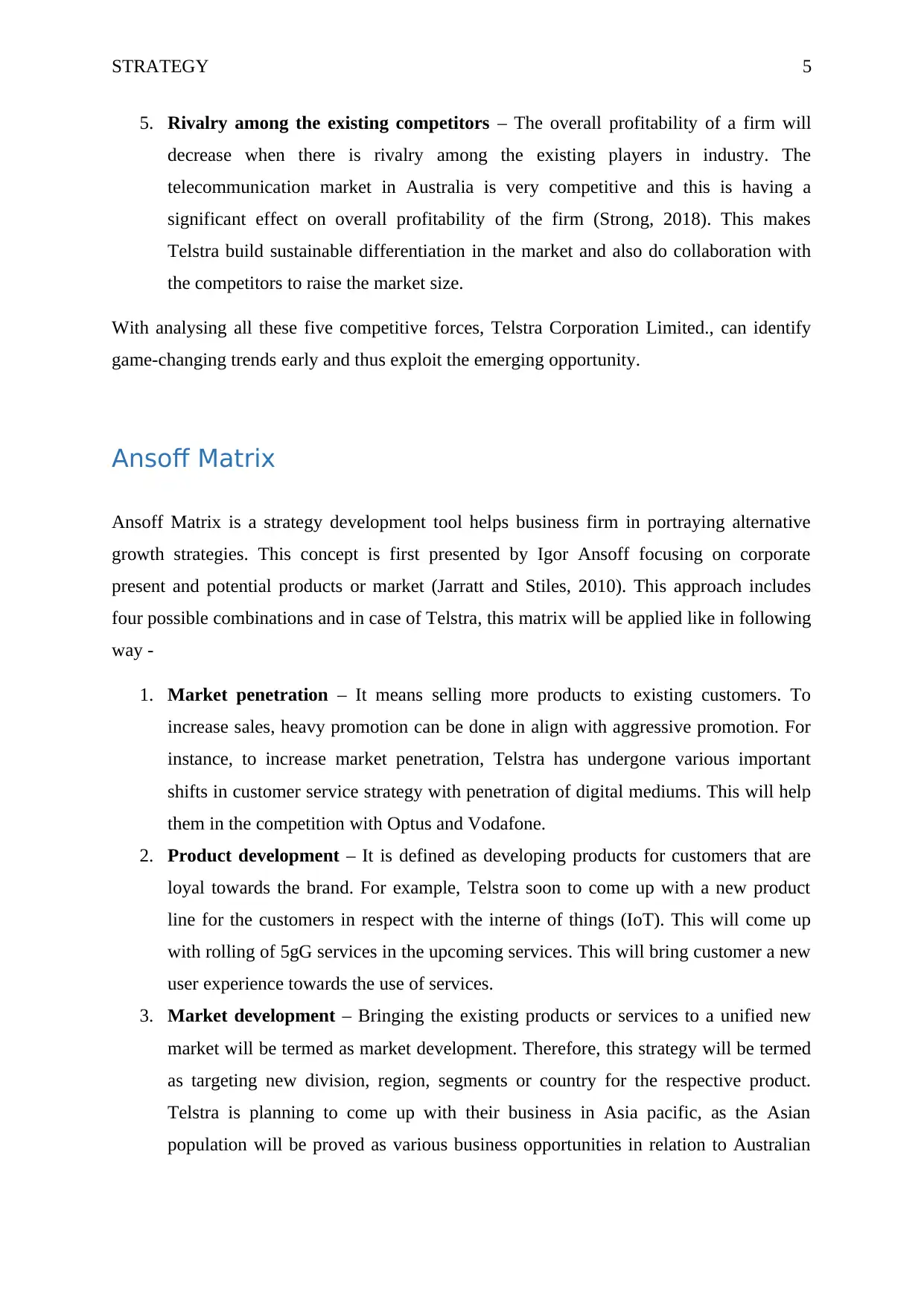
STRATEGY 5
5. Rivalry among the existing competitors – The overall profitability of a firm will
decrease when there is rivalry among the existing players in industry. The
telecommunication market in Australia is very competitive and this is having a
significant effect on overall profitability of the firm (Strong, 2018). This makes
Telstra build sustainable differentiation in the market and also do collaboration with
the competitors to raise the market size.
With analysing all these five competitive forces, Telstra Corporation Limited., can identify
game-changing trends early and thus exploit the emerging opportunity.
Ansoff Matrix
Ansoff Matrix is a strategy development tool helps business firm in portraying alternative
growth strategies. This concept is first presented by Igor Ansoff focusing on corporate
present and potential products or market (Jarratt and Stiles, 2010). This approach includes
four possible combinations and in case of Telstra, this matrix will be applied like in following
way -
1. Market penetration – It means selling more products to existing customers. To
increase sales, heavy promotion can be done in align with aggressive promotion. For
instance, to increase market penetration, Telstra has undergone various important
shifts in customer service strategy with penetration of digital mediums. This will help
them in the competition with Optus and Vodafone.
2. Product development – It is defined as developing products for customers that are
loyal towards the brand. For example, Telstra soon to come up with a new product
line for the customers in respect with the interne of things (IoT). This will come up
with rolling of 5gG services in the upcoming services. This will bring customer a new
user experience towards the use of services.
3. Market development – Bringing the existing products or services to a unified new
market will be termed as market development. Therefore, this strategy will be termed
as targeting new division, region, segments or country for the respective product.
Telstra is planning to come up with their business in Asia pacific, as the Asian
population will be proved as various business opportunities in relation to Australian
5. Rivalry among the existing competitors – The overall profitability of a firm will
decrease when there is rivalry among the existing players in industry. The
telecommunication market in Australia is very competitive and this is having a
significant effect on overall profitability of the firm (Strong, 2018). This makes
Telstra build sustainable differentiation in the market and also do collaboration with
the competitors to raise the market size.
With analysing all these five competitive forces, Telstra Corporation Limited., can identify
game-changing trends early and thus exploit the emerging opportunity.
Ansoff Matrix
Ansoff Matrix is a strategy development tool helps business firm in portraying alternative
growth strategies. This concept is first presented by Igor Ansoff focusing on corporate
present and potential products or market (Jarratt and Stiles, 2010). This approach includes
four possible combinations and in case of Telstra, this matrix will be applied like in following
way -
1. Market penetration – It means selling more products to existing customers. To
increase sales, heavy promotion can be done in align with aggressive promotion. For
instance, to increase market penetration, Telstra has undergone various important
shifts in customer service strategy with penetration of digital mediums. This will help
them in the competition with Optus and Vodafone.
2. Product development – It is defined as developing products for customers that are
loyal towards the brand. For example, Telstra soon to come up with a new product
line for the customers in respect with the interne of things (IoT). This will come up
with rolling of 5gG services in the upcoming services. This will bring customer a new
user experience towards the use of services.
3. Market development – Bringing the existing products or services to a unified new
market will be termed as market development. Therefore, this strategy will be termed
as targeting new division, region, segments or country for the respective product.
Telstra is planning to come up with their business in Asia pacific, as the Asian
population will be proved as various business opportunities in relation to Australian
⊘ This is a preview!⊘
Do you want full access?
Subscribe today to unlock all pages.

Trusted by 1+ million students worldwide
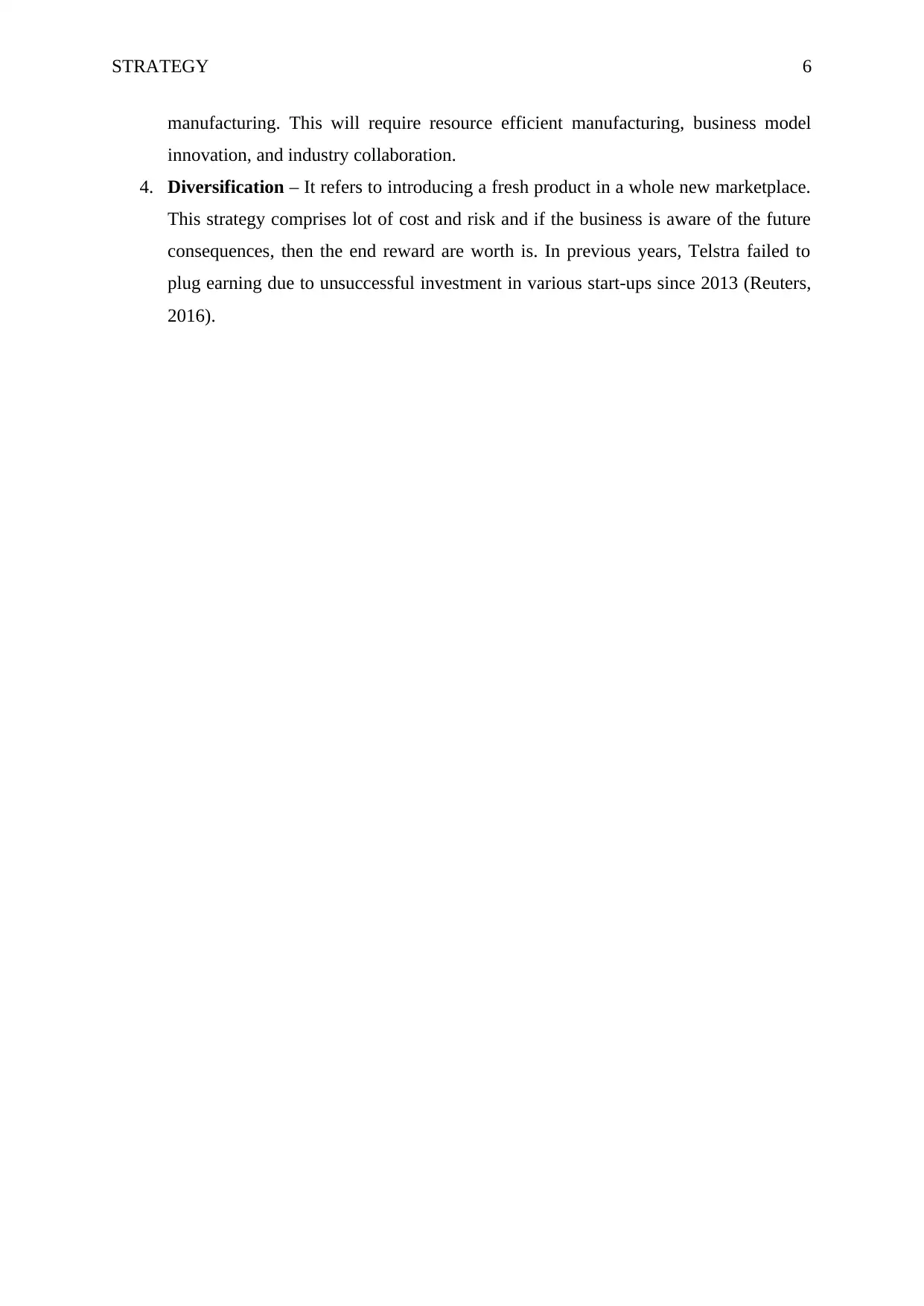
STRATEGY 6
manufacturing. This will require resource efficient manufacturing, business model
innovation, and industry collaboration.
4. Diversification – It refers to introducing a fresh product in a whole new marketplace.
This strategy comprises lot of cost and risk and if the business is aware of the future
consequences, then the end reward are worth is. In previous years, Telstra failed to
plug earning due to unsuccessful investment in various start-ups since 2013 (Reuters,
2016).
manufacturing. This will require resource efficient manufacturing, business model
innovation, and industry collaboration.
4. Diversification – It refers to introducing a fresh product in a whole new marketplace.
This strategy comprises lot of cost and risk and if the business is aware of the future
consequences, then the end reward are worth is. In previous years, Telstra failed to
plug earning due to unsuccessful investment in various start-ups since 2013 (Reuters,
2016).
Paraphrase This Document
Need a fresh take? Get an instant paraphrase of this document with our AI Paraphraser
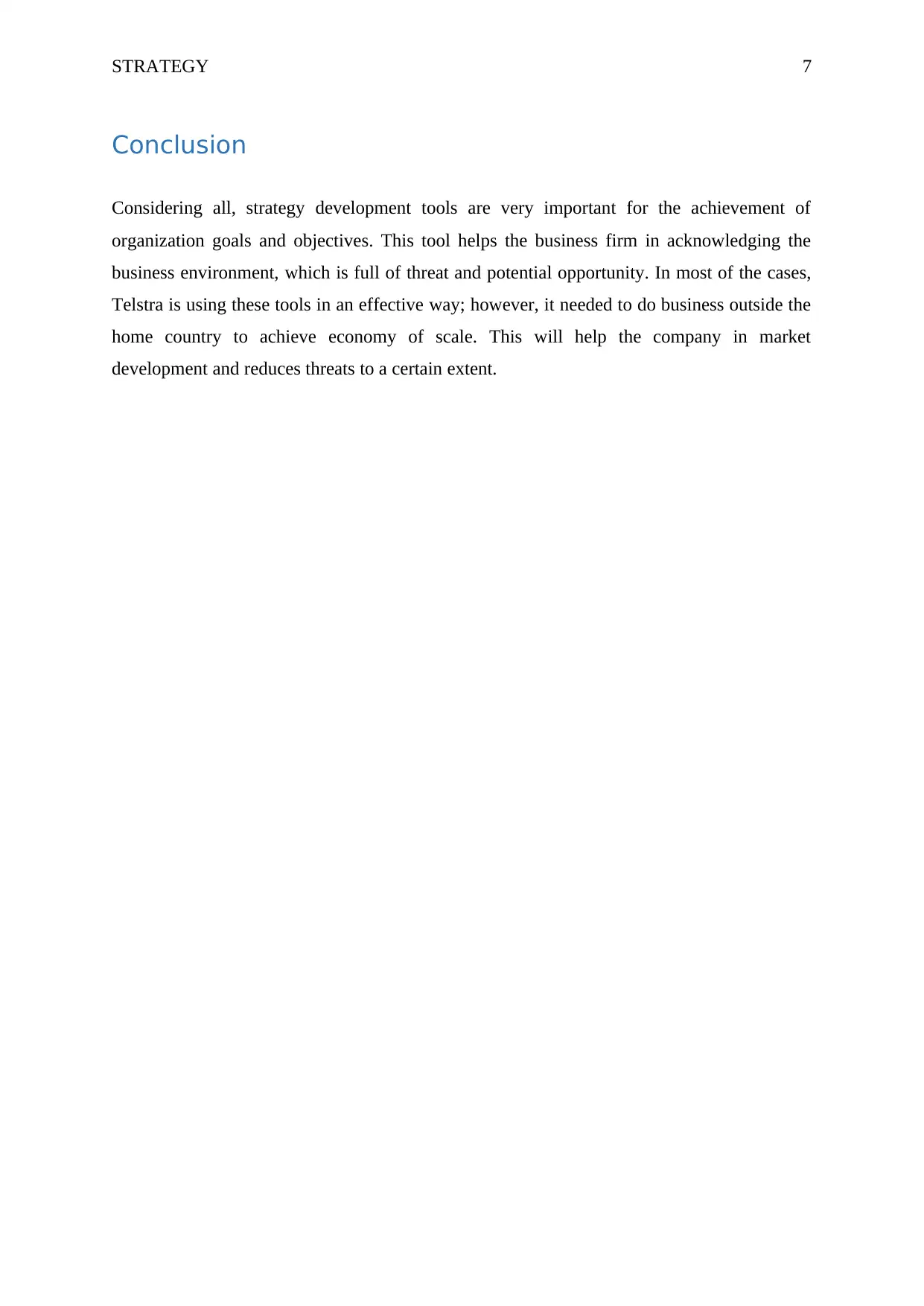
STRATEGY 7
Conclusion
Considering all, strategy development tools are very important for the achievement of
organization goals and objectives. This tool helps the business firm in acknowledging the
business environment, which is full of threat and potential opportunity. In most of the cases,
Telstra is using these tools in an effective way; however, it needed to do business outside the
home country to achieve economy of scale. This will help the company in market
development and reduces threats to a certain extent.
Conclusion
Considering all, strategy development tools are very important for the achievement of
organization goals and objectives. This tool helps the business firm in acknowledging the
business environment, which is full of threat and potential opportunity. In most of the cases,
Telstra is using these tools in an effective way; however, it needed to do business outside the
home country to achieve economy of scale. This will help the company in market
development and reduces threats to a certain extent.
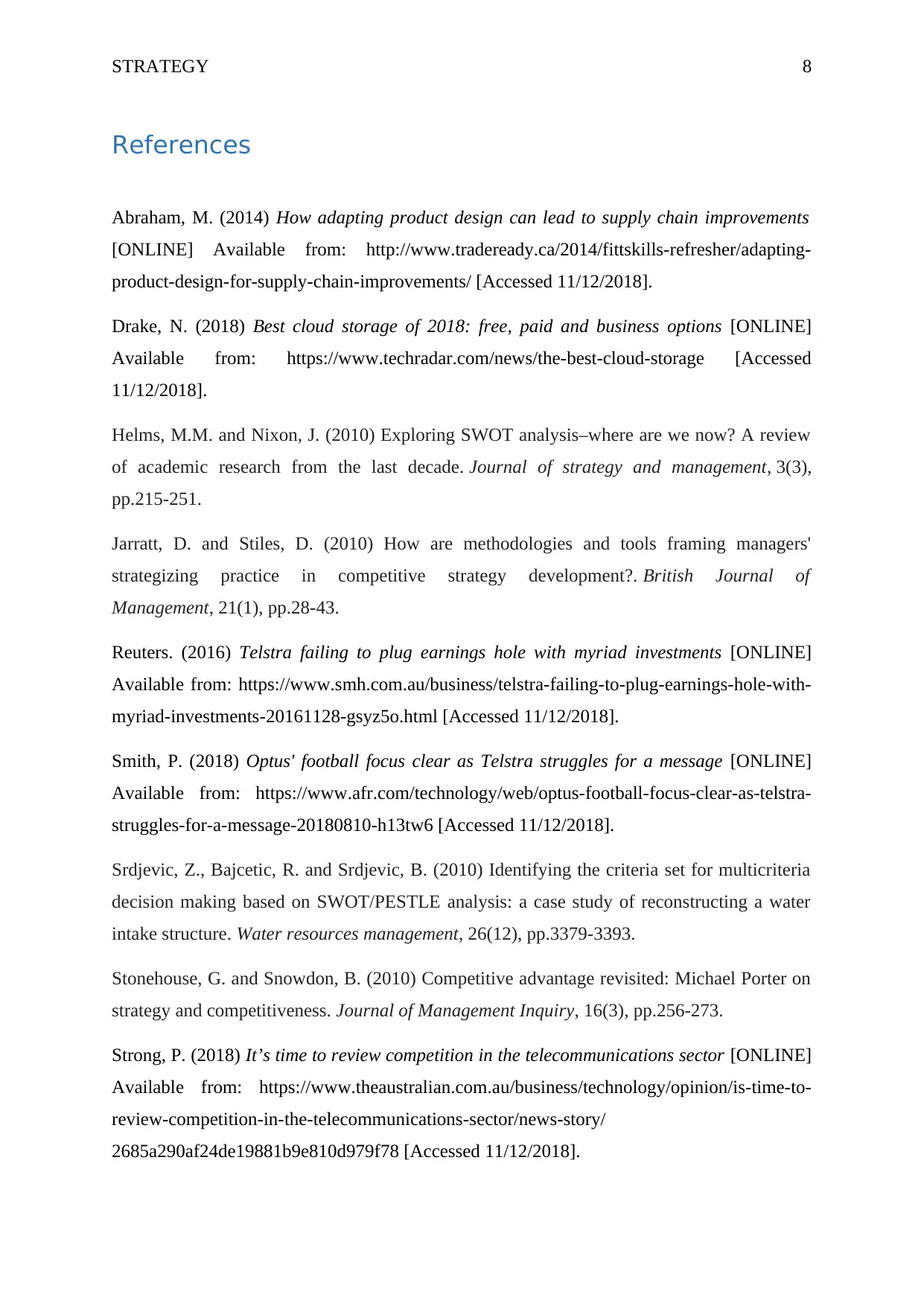
STRATEGY 8
References
Abraham, M. (2014) How adapting product design can lead to supply chain improvements
[ONLINE] Available from: http://www.tradeready.ca/2014/fittskills-refresher/adapting-
product-design-for-supply-chain-improvements/ [Accessed 11/12/2018].
Drake, N. (2018) Best cloud storage of 2018: free, paid and business options [ONLINE]
Available from: https://www.techradar.com/news/the-best-cloud-storage [Accessed
11/12/2018].
Helms, M.M. and Nixon, J. (2010) Exploring SWOT analysis–where are we now? A review
of academic research from the last decade. Journal of strategy and management, 3(3),
pp.215-251.
Jarratt, D. and Stiles, D. (2010) How are methodologies and tools framing managers'
strategizing practice in competitive strategy development?. British Journal of
Management, 21(1), pp.28-43.
Reuters. (2016) Telstra failing to plug earnings hole with myriad investments [ONLINE]
Available from: https://www.smh.com.au/business/telstra-failing-to-plug-earnings-hole-with-
myriad-investments-20161128-gsyz5o.html [Accessed 11/12/2018].
Smith, P. (2018) Optus' football focus clear as Telstra struggles for a message [ONLINE]
Available from: https://www.afr.com/technology/web/optus-football-focus-clear-as-telstra-
struggles-for-a-message-20180810-h13tw6 [Accessed 11/12/2018].
Srdjevic, Z., Bajcetic, R. and Srdjevic, B. (2010) Identifying the criteria set for multicriteria
decision making based on SWOT/PESTLE analysis: a case study of reconstructing a water
intake structure. Water resources management, 26(12), pp.3379-3393.
Stonehouse, G. and Snowdon, B. (2010) Competitive advantage revisited: Michael Porter on
strategy and competitiveness. Journal of Management Inquiry, 16(3), pp.256-273.
Strong, P. (2018) It’s time to review competition in the telecommunications sector [ONLINE]
Available from: https://www.theaustralian.com.au/business/technology/opinion/is-time-to-
review-competition-in-the-telecommunications-sector/news-story/
2685a290af24de19881b9e810d979f78 [Accessed 11/12/2018].
References
Abraham, M. (2014) How adapting product design can lead to supply chain improvements
[ONLINE] Available from: http://www.tradeready.ca/2014/fittskills-refresher/adapting-
product-design-for-supply-chain-improvements/ [Accessed 11/12/2018].
Drake, N. (2018) Best cloud storage of 2018: free, paid and business options [ONLINE]
Available from: https://www.techradar.com/news/the-best-cloud-storage [Accessed
11/12/2018].
Helms, M.M. and Nixon, J. (2010) Exploring SWOT analysis–where are we now? A review
of academic research from the last decade. Journal of strategy and management, 3(3),
pp.215-251.
Jarratt, D. and Stiles, D. (2010) How are methodologies and tools framing managers'
strategizing practice in competitive strategy development?. British Journal of
Management, 21(1), pp.28-43.
Reuters. (2016) Telstra failing to plug earnings hole with myriad investments [ONLINE]
Available from: https://www.smh.com.au/business/telstra-failing-to-plug-earnings-hole-with-
myriad-investments-20161128-gsyz5o.html [Accessed 11/12/2018].
Smith, P. (2018) Optus' football focus clear as Telstra struggles for a message [ONLINE]
Available from: https://www.afr.com/technology/web/optus-football-focus-clear-as-telstra-
struggles-for-a-message-20180810-h13tw6 [Accessed 11/12/2018].
Srdjevic, Z., Bajcetic, R. and Srdjevic, B. (2010) Identifying the criteria set for multicriteria
decision making based on SWOT/PESTLE analysis: a case study of reconstructing a water
intake structure. Water resources management, 26(12), pp.3379-3393.
Stonehouse, G. and Snowdon, B. (2010) Competitive advantage revisited: Michael Porter on
strategy and competitiveness. Journal of Management Inquiry, 16(3), pp.256-273.
Strong, P. (2018) It’s time to review competition in the telecommunications sector [ONLINE]
Available from: https://www.theaustralian.com.au/business/technology/opinion/is-time-to-
review-competition-in-the-telecommunications-sector/news-story/
2685a290af24de19881b9e810d979f78 [Accessed 11/12/2018].
⊘ This is a preview!⊘
Do you want full access?
Subscribe today to unlock all pages.

Trusted by 1+ million students worldwide

STRATEGY 9
Wright, C., Clibborn S., Piper, N and Cini, N. (2016) ECONOMIC MIGRATION AND
AUSTRALIA IN THE 21ST CENTURY [ONLINE] Available from:
https://www.lowyinstitute.org/publications/economic-migration-and-australia-21st-century
[Accessed 11/12/2018].
Wright, C., Clibborn S., Piper, N and Cini, N. (2016) ECONOMIC MIGRATION AND
AUSTRALIA IN THE 21ST CENTURY [ONLINE] Available from:
https://www.lowyinstitute.org/publications/economic-migration-and-australia-21st-century
[Accessed 11/12/2018].
1 out of 10
Related Documents
Your All-in-One AI-Powered Toolkit for Academic Success.
+13062052269
info@desklib.com
Available 24*7 on WhatsApp / Email
![[object Object]](/_next/static/media/star-bottom.7253800d.svg)
Unlock your academic potential
Copyright © 2020–2025 A2Z Services. All Rights Reserved. Developed and managed by ZUCOL.




